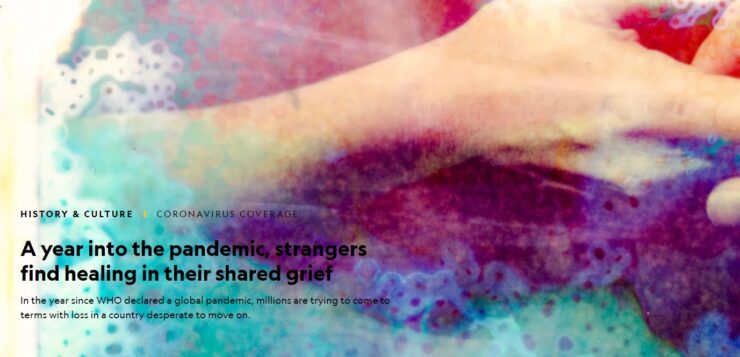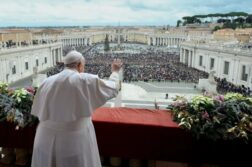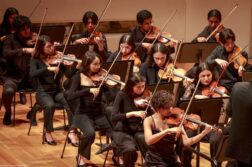In the year since WHO declared a global pandemic, millions are trying to come to terms with loss in a country desperate to move on.

BY NINA STROCHLIC
Shortly before Christmas, Flor Betancourt visited her neurologist for a routine appointment. She couldn’t help but mention that her younger brother died of COVID-19 last spring, and hadn’t called or texted her to say goodbye. Since last April 26, she’d been torturing herself and everyone she knew with the same question: Why hadn’t Juan called her from the hospital or answered her calls?
Both of Juan Vazquez’s legs had been amputated due to complications from diabetes, making it nearly impossible for him to get around. From his perch at the window of his ground floor apartment in Brooklyn he’d hand out dog treats and take in his neighbors’ packages. Betancourt doesn’t know how her brother contracted the virus, but before he was put in the ambulance, she reached him by phone: she told him she loved him and reminded him to take his phone charger. Vazquez never answered her calls again. He died nine days later.
In the neurologist’s office, Betancourt sobbed, her heart tight. “I want to explain something to you,” the doctor consoled her. “Patients with COVID become hypoxic. They go into a brain fog. There’s no oxygen going to their brain.” The autopsy had concluded Vazquez had died of hypoxia. Something clicked in Betancourt. He didn’t call because he couldn’t think.
Betancourt felt physically elated. She called a close coworker, then her mom. She told her husband, and later her counselor. “From there I knew I could let go of 99 percent of the grief,” she says. “I was fixated on that thing: why he didn’t call. I couldn’t let it go. And after that I said, this is it—move on.”
The second pandemic
A year since the World Health Organization declared a global pandemic, millions of Americans who have lost loved ones during the pandemic are trying to find ways to heal against the backdrop of a second wave of infections and a country desperate to move on.
“People are talking about the second pandemic as the ‘loss pandemic,’ or the ‘grief pandemic,’” says Dr. M. Katherine Shear, founder and director of Columbia University’s Center for Complicated Grief. A June study counted an average of nine immediate family members left in mourning for each person who dies of COVID-19. With the U.S. death toll now past half a million people, that means more than 4.5 million Americans are grieving lost family, not to mention many millions more who lost friends, colleagues, and neighbors.
“Prolonged grief disorder”—which will soon officially enter the Diagnostic and Statistical Manual of Mental Disorders, the bible of the American Psychiatric Association— leaves those in mourning with a crippling sadness that affects their ability to function and lasts longer than usual.
The Center for Complicated Grief has never been so busy. Shear founded it eight years ago with the conviction that some types of grief don’t respond to antidepressants or traditional psychotherapy. The treatment she developed moves patients through seven healing milestones— from acceptance to connecting peacefully with memories of the deceased.
Shear and her staff spent the summer of 2020 leading webinars for clinicians through New York City’s mental health department, and for professionals in Norway, the U.K., and China. They plan to double the number of workshops this year and create a virtual version of the therapy as well.
Shear says COVID has caused a dramatic spike in complicated grief. Even as a grief researcher, it’s hard for her to comprehend the magnitude of suffering across the country.
The solidarity of strangers
In June, before her father died, Rose Carmen Goldberg wrote an op-ed for the East Bay Times, a local paper in the Bay Area, where she’s a law professor at the University of California, Berkeley. In “Losing and Finding My Dad During the Coronavirus Pandemic,” she described how her father, Harold Jay Goldberg, had been placed in a nursing facility after having a stroke and how she had to watch through the glass doors of his room as he struggled to understand why she couldn’t come inside. “I have nightmares about him dying alone and afraid,” she wrote.
A month later, after her father died, she wrote an op-ed for USA Today. Goldberg had been allowed to visit, but her sister lived far away, and her mother was strictly quarantined. “I read him a poem,” she wrote. “I knew he could hear me because he squeezed my hand at his favorite lines.”
After, she went to see her mom. They stood on the sidewalk outside the house, sobbing, unable to go inside, unable to hug.
When the hospice workers encouraged her to join a virtual grief group, Goldberg declined. “Being on a computer sounded like the opposite of healing,” she says. Every day the news bombarded her with death tolls. She didn’t want more.
But one night four months later, she closed the door to her bedroom and logged on to Zoom. A cardboard box sat nearby with scraps of her father’s poetry and knickknacks from his apartment. Two facilitators and seven participants appeared in a grid. “I’m Rose and my dad died,” she said, and a feeling of catharsis washed over her. One woman had lost her husband of 65 years. A single mother had lost her mother. Another daughter had lost her father, a former Marine.
“Grief needs to be witnessed,” a facilitator said, and Goldberg knew it was true. “There was something about the witnessing that was healing,” she says. “It helped me make sense of what happened.”
She no longer cries so hard that she can’t speak when her dad’s name comes up. She thinks back to the time before she visited him through glass doors.
On New Year’s Day, she wrote a final op-ed, for the Los Angeles Times, that inspired readers to write to her about their own losses: A high schooler whose brother had died. A salesman who lost both his parents. Others told her they decided to join grief groups as well.
“I imagined I’d find Brady Bunch squares of grievers, a pixelated quilt of strange sad faces. I wondered if it made sense to sign up for more darkness,” she wrote. “What I found, though, were heartbroken but whole people. Like me. Struggling through the pandemic and longing for a new future, while learning how to build bridges with loved ones lost to the past.”
Fighting back with activism
On July 8, the day of her father’s funeral, Kristin Urquiza published what she called an “honest obituary” in the Arizona Republic. It described Mark Anthony Urquiza as “a lover of nature” and “the life of the party.” Then it continued: “His death is due to the carelessness of the politicians who continue to jeopardize the health of brown bodies through a clear lack of leadership, refusal to acknowledge the severity of this crisis, and inability and unwillingness to give clear and decisive direction on how to minimize risk.”
In May, Arizona Governor Doug Ducey had reopened the state, and encouraged residents to resume their normal lives. Mark had gone to a karaoke bar with a few friends. Two and a half weeks later he was dead. Urquiza set up an altar outside the state capitol and invited the governor to the funeral.
“I felt such strong emotions,” says Urquiza. “It wasn’t just sadness; it was rage. I knew I needed to channel that into something, or I was terrified I would implode.” To her, fighting the pandemic with activism was the only way forward.
Urquiza took a leave from her job in San Francisco, and founded Marked by COVID, a resource and advocacy platform for those who’d lost loved ones in the pandemic. Every day, she speaks to a group of people she didn’t know a year ago. They live in Brownsville and Brooklyn and Jefferson City. They organize campaigns, plan protests, and lobby politicians. They are calling for a commission like the one formed after September 11 to investigate the federal response to the pandemic. Their bond is loss.
“I don’t think I can find peace with my father’s passing unless I know we’ve worked really hard to find peace for everybody’s passing,” says Urquiza.
The Democratic National Convention planners took note of Urquiza, and in August, she appeared in a pre-recorded video for the opening hour, blaming the country’s leadership for her father’s death. It quickly went viral.
On January 19, the evening before Joe Biden’s inauguration, Urquiza watched as lights went up around the Lincoln Memorial to honor the 400,000 Americans who had died of COVID. She was in Arizona with her mother, but she was joined by a virtual gathering of her advisory board, and nearly a thousand other participants. It was the first time the COVID losses had been honored at a national level.
“For many months we have grieved by ourselves,» Kamala Harris said in her speech. «Tonight we grieve, and begin healing, together.” After months of pandemic denial by politicians and the public, the simple ceremony gave Urquiza a type of relief she hadn’t felt since her dad had passed. For the first time, she says, she “could see healing on the horizon.”
Finding a virtual community
Sabila Khan became an insomniac after her father died. Late one night, a few days after she’d watched his burial on livestream from her home in New Jersey, she searched the internet for someone to talk to. In a COVID-related Facebook group, she asked if anyone knew of a bereavement group. She and another member, Angelina Proia, decided to make one.
Every day, the COVID-19 Loss Support for Families & Friends group fills with dozens of posts commemorating loved ones, asking for prayers, and sharing photographs of happier times. Members respond with yellow hearts, an indicator of their shared loss. Each week, Khan welcomes the new additions by name, and posts the resources she’s collected: dozens of links to free or affordable therapy, meditation classes on Tuesday, Zoom grief group on Friday nights and Saturday afternoons. They’re averaging 400 new members per week.
“Our country is facing a tsunami of grief,” Khan says. “This amount of trauma and loss is unprecedented in the modern era.”
Her father, Shafqat Khan, was a community organizer who moved his family from Pakistan to New Jersey and advocated for immigrant rights. Months after his death, his daughter saw her work as carrying on his legacy.
She knows that for some, there’s nowhere else to go and no one else to understand them. “Yes, it’s upsetting,” she says, “but this has become my purpose: To provide comfort for these people. I’m sitting in the trauma. I’m marinating in it.”
Every Friday night, a few dozen members log in to Zoom to talk face-to-face about what’s helping them cope, what’s not, what triggers their grief. They cry and laugh together. They talk about the jealousy of seeing pictures of recovered COVID patients being wheeled out of the ICU—and how guilty that makes them feel. Khan knows she’ll never really recover from how her father died—alone and unable to speak to his family.
But when she signs off from that group call about death, she feels full of life. “In those moments I feel that we are somehow mining the good out of this mountain of grief,” she says. “That’s what has been healing.”
A prayer for healing
Throughout history, societies have found public ways to mourn the dead: through clothing, ritual, and ceremony. This pandemic drastically altered the grieving process, but technology is resurrecting loss—and healing—as a collective experience.
On a recent Friday night, a grid of faces populated Flor Betancourt’s computer: her other brother in Manhattan, a cousin in Georgia, and Betancourt’s closest childhood friend who’s now a nurse in Florida.
When her younger brother, Juan, was buried, Betancourt and her mother began a Rosary Novena, nine days of prayer in the Catholic faith. She sent the link out via texts and emails. Her first Zoom Rosary had two dozen attendees. Now, six or seven family members and friends join each week.
One participant says her cousin died of COVID. A collective murmur comes from the squares. “Oh God,” says Betancourt. She adds him to the names they’ll be praying for, which has grown by dozens over the past 10 months. Then Betancourt begins the Rosary in rapid, rolling Spanish:
“Madre admirable,
Madre del buen consejo,
Madre de nuestro Creador,
Madre de nuestro Salvador.”
A green outline illuminating the speaker bounces between squares as the participants echo each line. “Ruega por nosotros”—pray for us.
“Oh, merciful God, embrace our family members who have died, including our nearest and dearest, Juan Vazquez,” Betancourt says. “We will always be grateful for the blessing of having known them. Help us understand that death is not an end but a new beginning.”
The faces in the squares respond with an amen and cross themselves, then begin their goodbyes.
“Next week, same time, 7:30,” says Betancourt. “I love you all.” She holds up her hands in the shape of a heart and signs off.





